Asus ZenBook Duo (UX482) Review
Asus ZenBook Duo (UX482) Review
A classy ultrabook with a dual-screen design
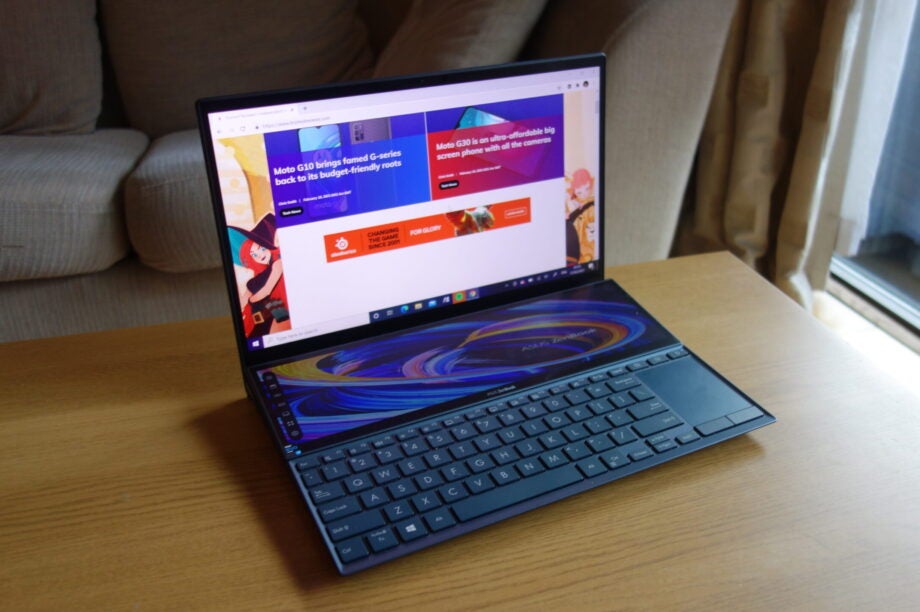
Verdict
The Asus ZenBook Duo is a great all-round Ultrabook, but the ScreenPad arguably adds more issues than benefits. While the second touchscreen is great for multitasking with apps such as Slack, Spotify and Premiere Pro, it also pushes the keyboard down to a more awkward position, limiting the appeal of this design.
Pros
- Excellent productivity performance
- Outstanding battery life
- ScreenPad is handy for apps
- Pleasingly portable
Cons
- Keyboard is uncomfortable to type on
- Screen isn't accurate enough for creative professionals
Key Specifications
- Review Price: £1499
- 14in 1920 x 1080 touchscreen
- Additional ScreenPad display
- Intel Core i7-1165G7 CPU
- Up to 32GB RAM
- Up to Nvidia GeForce MX450 GPU
- Up to 1TB SSD
- Dimensions: 324 x 222 x 16.9mm
- Weight: From 1.57kg
Don’t worry, you don’t have double vision. The Asus ZenBook Duo (UX482) genuinely does have two screens, with an additional panel embedded on the deck to make multitasking easier than ever.
This isn’t the first iteration of the ZenBook Duo, with this new 2021 model seeing software improvements to the ScreenPad as well as boosted specs such as Intel’s 11th-generation processor.
But the question remains: what’s the point in a secondary laptop screen? And is it really worth the compromises and extra cost over a more conventional laptop? After spending a couple of weeks with it, I’m not convinced, despite offering useful features for multitaskers and creative professionals alike.
Asus ZenBook Duo (UX482) price and availability
The Asus ZenBook Duo has an official starting price of around £1499 in the UK, which sees the laptop fitted with an Intel Core i7-1165G7 processor and 16GB of RAM. It’s also possible to beef up the RAM and storage, as well as adding a Nvidia MX450 GPU for added graphical grunt.
You can get an ever cheaper $999.99 configuration over in the US, which sees the laptop housing an Intel Core i5-1135G7 processor, 8GB of RAM and a 512GB SSD. It’s a shame this model isn’t currently available in the UK, since it could then compete more fiercely with the MacBook Air M1 and Surface Laptop 3.
However, third-party retailers do appear to be offering the laptop at a lower price than the RRP, with Newegg seemingly shipping the i7 model for £1254. The Asus ZenBook Duo has only just launched, and is proving difficult to find at other retailers at this time.
Design – Dual-screen compromises
-
ScreenPad is most useful for creation-focused apps
-
Awkward placement of keyboard results in uncomfortable typing
-
The Asus ZenBook Duo (UX482) is light and thin enough to slip in a bag
Let’s not skirt around the elephant in the room. How useful is the ScreenPad Plus secondary screen? After spending a few weeks with it, I’ve decided it really depends on the applications you frequently use.
Personally, I liked having the ability to drag Spotify down to the secondary touchscreen, so I could easily skip tracks or pause the music without having to ever leave my Word document on the main panel. I also quite enjoyed watching YouTube videos on it while I worked. However, I can’t help but think that I can already achieve such use with my smartphone, and at a more pleasing aspect ratio.
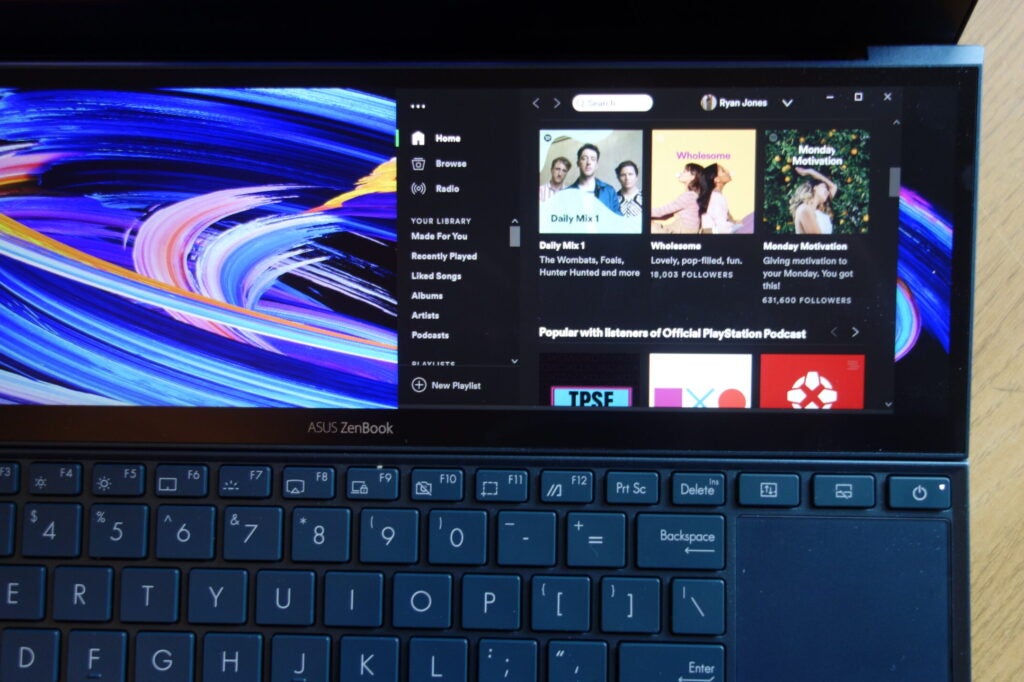
The ScreenPad makes more sense used in conjunction with a creative app, such as Adobe Photoshop, Lightroom Classic, Premiere Pro and After Effects, which all offer a useful touch-friendly control panel. Office-related apps such as Slack can also be moved down to the ScreenPad, so you can’t claim to have missed your boss’ nagging.
Asus has included additional features such as a handwriting app and number pad replacement, but it’s the quality of life improvements I’m most impressed by, with Asus making it easier than ever to navigate the ScreenPad Plus. It even supports stylus input, although Asus doesn’t include one for the price.
Asus has smartly propped up the ScreenPad on a hinge, which swings up as I open the laptop. This ensures I don’t have to strain my neck to keep my eyes glued to the display, while also providing the internals with extra room to breath, maximising performance.
Overall then, I quite like the idea of the ScreenPad – it feels like an evolution of Apple’s TouchBar that you’ll find on the MacBook Pro – but I’m not so pleased about the compromises Asus has had to make to free up room for the secondary screen.
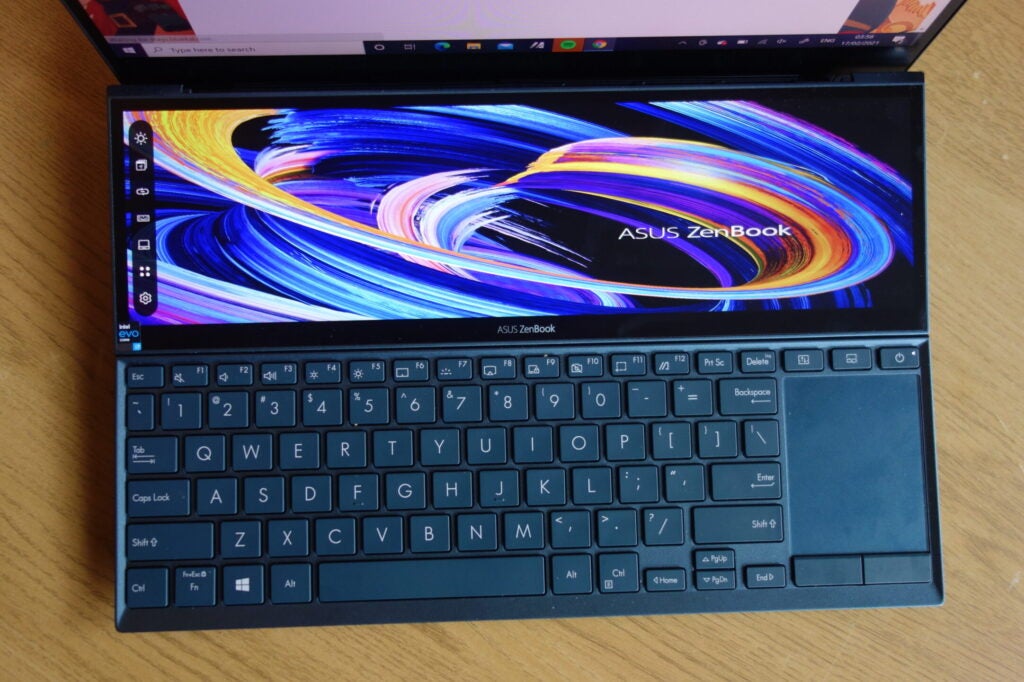
The keyboard has been shunted to the front of the deck, and the trackpad squeezed in where the number pad would usually be found, which will be a particular pain point for left-handers.
This peculiar design results in an awkward typing experience, with the keys feeling uncomfortably cramped and the lack of wrist-rest forcing me to sit further away from the laptop than I would normally. I really wouldn’t recommend this laptop if you need a portable for churning out long essays and reports.
To Asus’ credit, it has managed to keep the compromises to a minimum. The laptop is still relatively thin at 17.3mm, and its 1.57kg starting weight is heftier than conventional Ultrabooks, but still light enough for me to easily pop in a bag for transporting around town. The ZenBook Duo looks rather ugly when opened up, thanks to the unusual keyboard layout, but the thin screen bezel and glossy blue lid are undeniably classy.
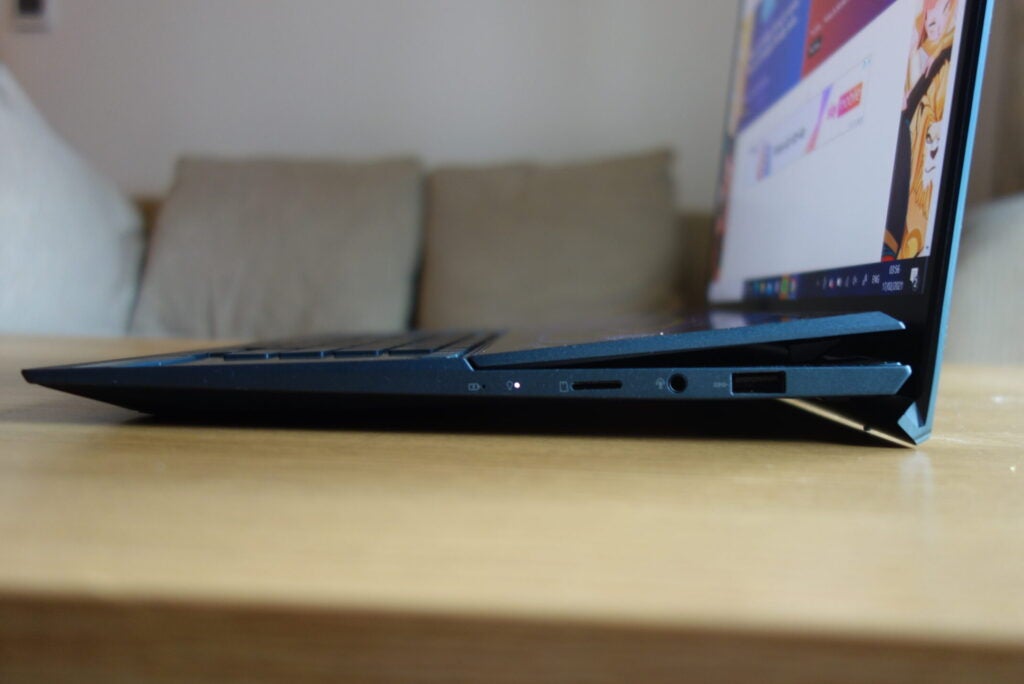
Asus has managed to fit in an abundance of ports, too, with USB-A, 2 x USB-C, HDMI, headphone jack and a microSD card all present. This is far more generous than what the Dell XPS 13 and MacBook Air offer.
A webcam offering so-so video quality sits above the main display, with a kill switch on the keyboard allowing you to cut the feed. Sadly, there’s no fingerprint scanner here, but you can still whizz through the login process thanks to the IR webcam with Windows Hello support.
Screen – The Asus ZenBook Duo (UX482) misses the mark for professional creatives
-
Brightness and contrast are pleasingly high
-
No 4K screen option available
-
Colour accuracy isn’t good enough for professionals
Asus is clearly pitching the ZenBook Duo as a laptop for professional creators, what with its ScreenPad support for Adobe Premiere Pro and its discrete GPU options. This gave me high hopes for its display quality, but the laptop failed to meet those expectations.
Don’t get me wrong, screen quality here is solid. Testing it with a colourimeter, I found the ZenBook Duo offers 340-nits of brightness and 1521:1 contrast, which are both above average scores for an Ultrabook. These results mean that dark and light shades will stand out more clearly, resulting in more detailed images whether you’re watching Netflix or editing photos.

The issue here is the colour coverage: 98.8% of sRGB is superb, but the underwhelming Adobe RGB and DCI-P3 results of 71% and 73.2% mean that photo-realistic images won’t appear as accurately as they would on, say, a MacBook Pro or Razer Blade 15 Studio Edition.
Again, the ZenBook Duo’s results are pretty typical for standard high-end ultrabooks, but if Asus wants to seriously chase the creative crowd then these results need to be better.
It’s also rather peculiar that there’s no 4K (or even Quad HD) model available, once again limiting the usefulness for professional content creators.
Performance – Asus ZenBook Duo (UX482) is Leading Windows Ultrabook power
-
Excellent productivity performance
-
Can be configured with a GeForce NX450 GPU
-
The Asus ZenBook Duo (UX482) has speedy SSD is impressive
Aside from the ScreenPad, the most noteworthy element of the 2021 model of the Asus ZenBook Duo is the inclusion of Intel’s 11th-generation processors. The laptop is available with either an Intel Core i5-1135G7 or Intel Core i7-1165G7 – Asus sent in the latter for review.
This is the same chip found in our Dell XPS 13 review unit, yet the Duo saw marginally superior results when I ran long-running benchmark tests such as PCMark 10 and 3DMark TimeSpy. This suggests Asus’ clever ScreenPad hinge is successful at improving airflow for the internals and squeezing out that extra performance power.
| Asus ZenBook Duo (Intel Core i7-1165G7) |
Dell XPS 13 (Intel Core i7-1165G7) |
MacBook Air (Apple M1) |
|
| PCMark 10 | 4991 | 4802 | – |
| Geekbench 5 (single core) |
1564 | 1548 | 1731 |
| Geekbench 5 (multi core) |
5403 | 5687 | 7308 |
| 3DMark TimeSpy | 1819 | 1657 | – |
You can’t ignore the fact that the MacBook Air saw significantly better results in Geekbench, ensuring Apple still boasts the most powerful ultrabook you can currently buy. But does the performance gap matter? For general day-to-day tasks, the Duo is comfortably powerful enough to ensure speedy performance, no matter how many web browsers you have open. It even has the performance capabilities for light photo and video work.
Asus is also offering the discrete Nvidia GeForce NX450 GPU for those who want to push the graphical performance up a notch. Note that this is still an entry-level performance for content creators, with the likes of the MacBook Pro offering significantly more power.
The Duo also has a lightning-fast SSD, with a 3553MB/s read speed and 2993MB/s write speed – which are pretty much the best scores you can find in an ultrabook right now. This means loading and saving data on the drive will be a speedy process, which is important for those working with photos and videos.
Battery – Outstanding stamina with and without ScreenPad
-
Battery lasted 10hrs 7mins with the ScreenPad in use
-
Deactivating the ScreenPad added an extra six hours
One of the major concerns about the ScreenPad is the level of battery drain it could have on the laptop.
However, Asus has done an excellent job of improving the laptop’s efficiency, with the Duo lasting a remarkable 10hrs 7mins with the ScreenPad activated during the PCMark 10 office battery simulation.
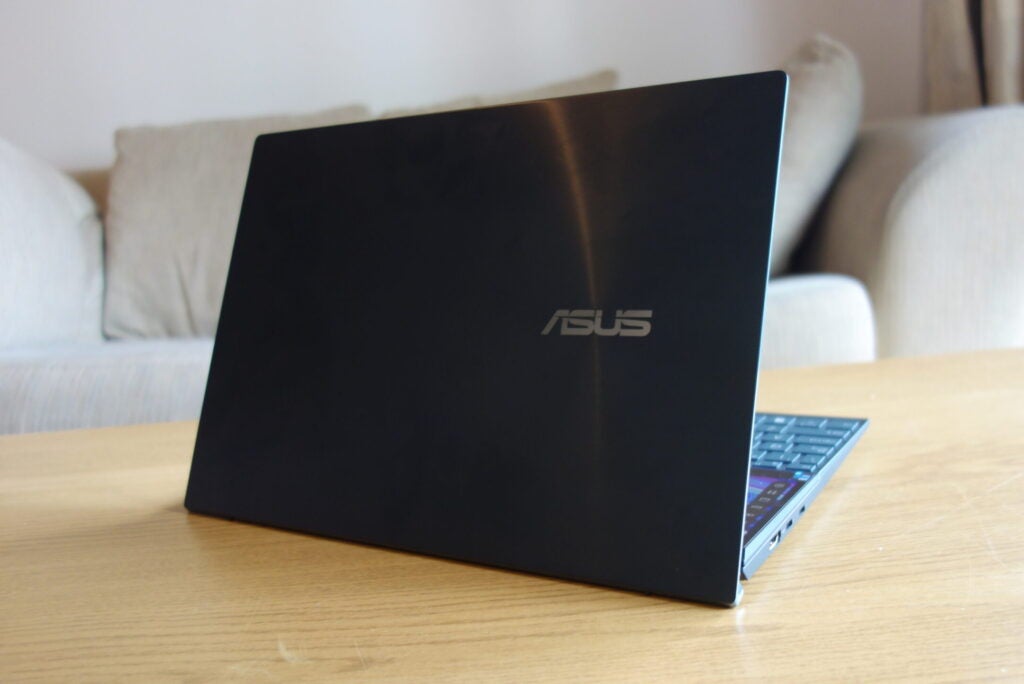
The ScreenPad remains a leech on the battery, though. I repeated the test with the ScreenPad turned off and the laptop managed to chug away for a whopping 16hrs 30mins.
This result is so impressive that I genuinely wish I could scrap the ScreenPad altogether, as an extra six hours of stamina is arguably more valuable than being able to display the likes of Slack, Spotify and YouTube on a secondary screen. That said, the 10-hour battery life with the ScreenPad activated is still long enough to outlast a working day, so I can’t complain too much.
You should buy the Asus ZenBook Duo (UX482) if…
- You want to multitask while you work
The ScreenPad allows you to keep an eye on Slack, control your Spotify playlist, or even watch a YouTube video without ever leaving your Word document.
- You want to engage with entry-level photo and video editing
The ScreenPad is also rather useful for content creation apps as a result of the customisable control panel, although the laptop lacks the grunt for professional-grade work.
- You’re looking for a laptop with a great battery
I’m very impressed with the battery life, especially with the ScreenPad deactivated. There are few ultrabooks better in this area.
You shouldn’t buy the Asus ZenBook Duo (UX482) if…
- You don’t care about the ScreenPad
The laptop’s entire design revolves around this space-hogging ScreenPad, so we strongly recommend you look elsewhere if you don’t fancy the look of it.
- You want a laptop for high-end content creation
The screen’s average colour accuracy and lack of powerful discrete GPU means the Duo isn’t the best choice for demanding photo/video work. If you’re a professional content creator, check out the MacBook Pro or Razer Blade 15 Studio Edition instead.
- You need to write a lot of reports or essays
The Duo features one of the most uncomfortable keyboards I’ve ever tested. If you have a job or university course that requires a lot of typing, I strongly recommend you opt for a laptop with a more conventional keyboard layout.
How we test laptops
Unlike other sites, we test every laptop we review thoroughly over an extended period of time. We use industry standard tests to compare features properly. We’ll always tell you what we find. We never, ever, accept money to review a product.


